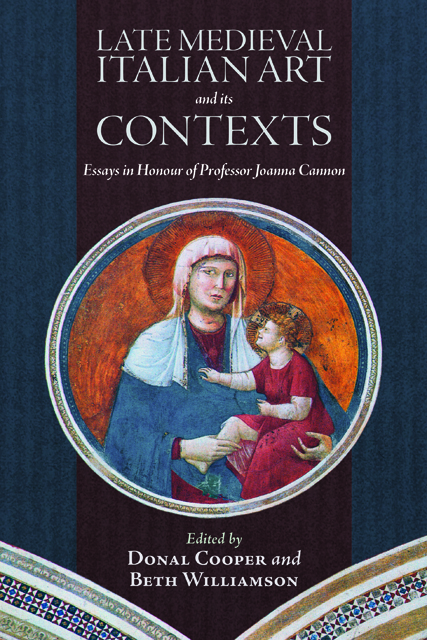Book contents
- Frontmatter
- Contents
- List of Illustrations
- List of Contributors
- Acknowledgements
- List of Abbreviations
- 1 Introduction: Circling Giotto
- 2 Holy Wood / ‘sacra tavola’: Saint Dominic and the Memory of Miracles in Bologna
- 3 The Sculpted Saint: A Statue of Saint Francis in Siena
- 4 Guccio di Mannaia and the Concept of a ‘Franciscan’ Chalice
- 5 ‘Speculum sine macula’: The Trittico di Santa Chiara in Trieste as an Object of Clarissan Devotion
- 6 The Siena Connection: A Franciscan Provincial Minister between Tuscany and Assisi at the Dawn of the Trecento
- 7 Simone Martini’s ‘Treaty with the House of Santa Fiora’ in Siena’s Palazzo Pubblico: Its Date and Significance
- 8 Crisis and Charity in Fourteenth-Century Florence: Ambrogio Lorenzetti’s Saint Nicholas Panels for San Procolo
- 9 Father of Light: Giotto and the Beatific Vision in the Baroncelli Chapel
- 10 Painter-Illuminator Workshops and the Church of San Giorgio a Ruballa: The Case of Bernardo Daddi and Pacino di Bonaguida
- 11 Patterns of Holiness: A Virgin Lactans in a Franciscan Context
- 12 A New Angle on Simone Martini’s Holy Family
- 13 Artistic Appropriation, Institutional Identity, and Civic Religion in Fourteenth-Century Siena: The Byzantine Treasury of the Hospital of Santa Maria della Scala
- 14 Visual Religious Education in Late Medieval Florence: Zanobi Perini, The Leggenda di Santo Tobia, and The Misericordia
- 15 Saints and Status in Late Medieval and Early Renaissance Florence
- Select Bibliography
- Publications by Joanna Cannon
- Index
- Tabula Gratulatoria
- Backmatter
11 - Patterns of Holiness: A Virgin Lactans in a Franciscan Context
Published online by Cambridge University Press: 20 December 2022
- Frontmatter
- Contents
- List of Illustrations
- List of Contributors
- Acknowledgements
- List of Abbreviations
- 1 Introduction: Circling Giotto
- 2 Holy Wood / ‘sacra tavola’: Saint Dominic and the Memory of Miracles in Bologna
- 3 The Sculpted Saint: A Statue of Saint Francis in Siena
- 4 Guccio di Mannaia and the Concept of a ‘Franciscan’ Chalice
- 5 ‘Speculum sine macula’: The Trittico di Santa Chiara in Trieste as an Object of Clarissan Devotion
- 6 The Siena Connection: A Franciscan Provincial Minister between Tuscany and Assisi at the Dawn of the Trecento
- 7 Simone Martini’s ‘Treaty with the House of Santa Fiora’ in Siena’s Palazzo Pubblico: Its Date and Significance
- 8 Crisis and Charity in Fourteenth-Century Florence: Ambrogio Lorenzetti’s Saint Nicholas Panels for San Procolo
- 9 Father of Light: Giotto and the Beatific Vision in the Baroncelli Chapel
- 10 Painter-Illuminator Workshops and the Church of San Giorgio a Ruballa: The Case of Bernardo Daddi and Pacino di Bonaguida
- 11 Patterns of Holiness: A Virgin Lactans in a Franciscan Context
- 12 A New Angle on Simone Martini’s Holy Family
- 13 Artistic Appropriation, Institutional Identity, and Civic Religion in Fourteenth-Century Siena: The Byzantine Treasury of the Hospital of Santa Maria della Scala
- 14 Visual Religious Education in Late Medieval Florence: Zanobi Perini, The Leggenda di Santo Tobia, and The Misericordia
- 15 Saints and Status in Late Medieval and Early Renaissance Florence
- Select Bibliography
- Publications by Joanna Cannon
- Index
- Tabula Gratulatoria
- Backmatter
Summary
The Detroit Institute of Arts houses a small wooden panel (13 × 9.2 × 1.6 cm), originally one half of a fourteenth-century Italian reliquary diptych (Plate XV). The gilt wooden frame encloses a rectangular piece of verre églomisé, or gilded glass, which depicts the Virgin Mary, enthroned, and nursing the Christ Child on her knee. Surrounding this central image of the Virgin Lactans are painted decorative leaf forms, in gold, on red or black backgrounds. In between these leaf forms are clear glass windows, through which sections of parchment are visible behind. There are small openings in the parchments themselves, which reveal tiny relic fragments underneath. The relics are accompanied by identifying texts written in red ink on the relevant parchment.
The object entered the DIA collection in 1994, having been purchased at auction in that year, and remains almost completely unpublished, save for the sale catalogue of the dealer from which the Detroit Institute of Art acquired the piece, and a brief notice in the DIA Views magazine in December 1994 following its acquisition. The Detroit reliquary panel is not featured in any of the main published studies on gilded glass reliquaries, nor in studies of gilded glass more widely. It is mentioned in an unpublished 2005 Masters dissertation from The Courtauld Institute by Irene Galandra (and supervised by Joanna Cannon), but otherwise it has received almost no scholarly attention.
The Detroit gilded glass offers a suitable topic for a Festschrift essay for Joanna Cannon, for reasons pertinent both to Joanna’s own interests and to my own development as an academic researcher. First, it presents the opportunity for a close study of an individual object, with particular attention both to its physical and material characteristics, and also to its iconographical particularities: these are both key interests in Joanna’s work. Secondly, many of the surviving examples of gilded glass panels of this period seem to have been produced for use in a Franciscan context. Some of them are still in locations associated with the Franciscan Order, or have a secure Franciscan provenance.
- Type
- Chapter
- Information
- Late Medieval Italian Art and its ContextsEssays in Honour of Professor Joanna Cannon, pp. 203 - 228Publisher: Boydell & BrewerPrint publication year: 2022



